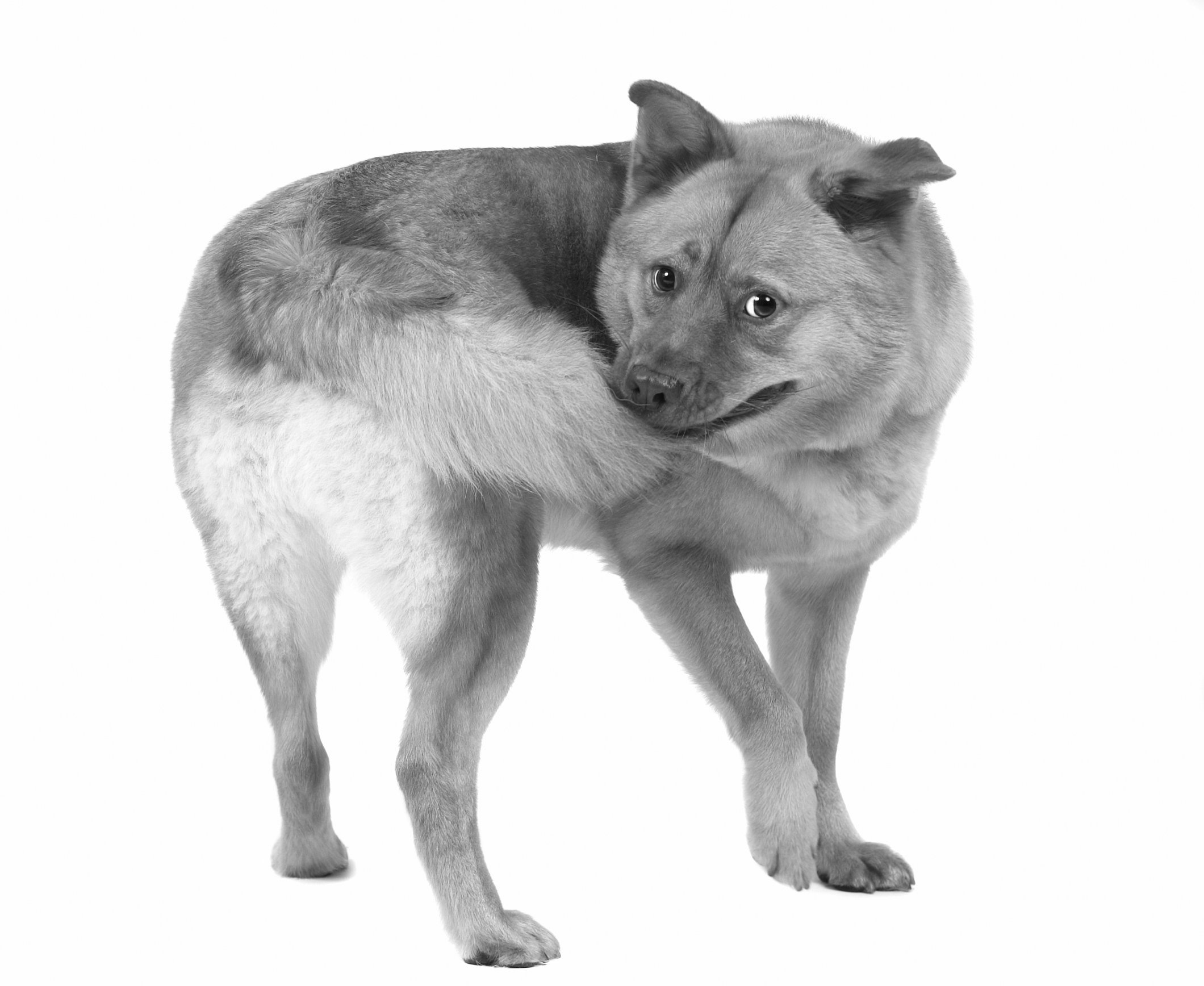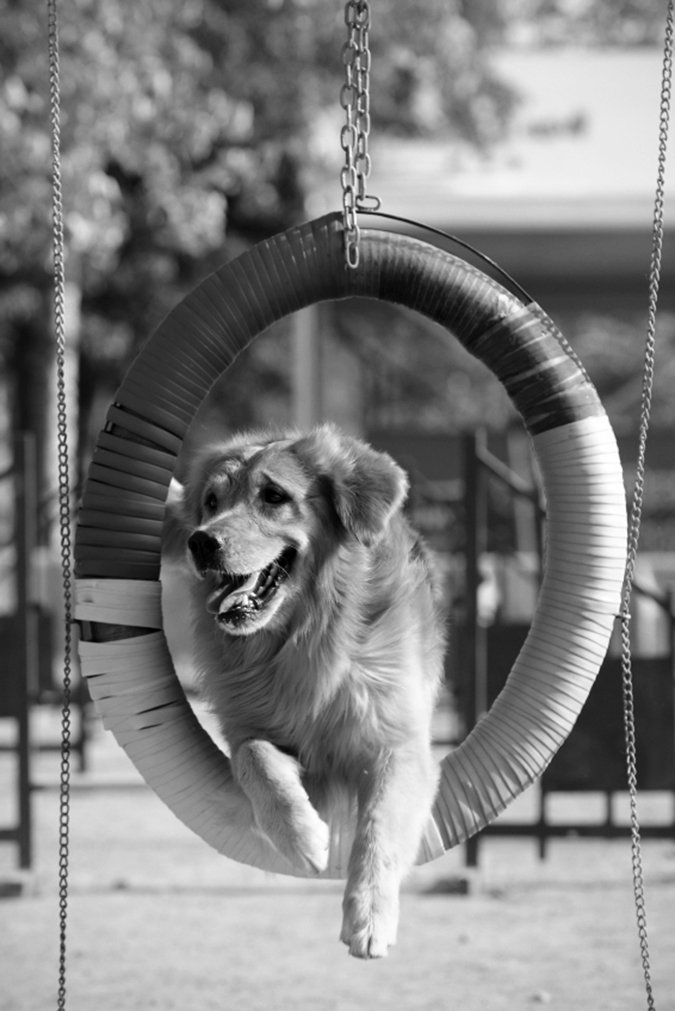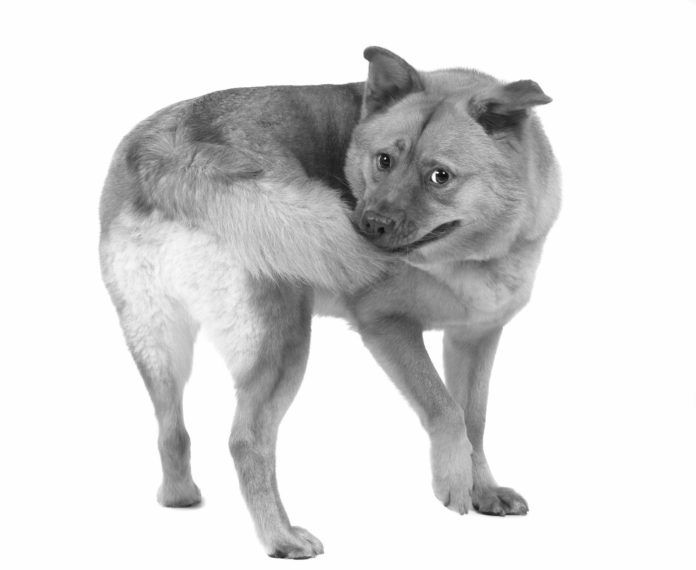For some dogs it’s tail chasing, or chasing lights and shadows to the point of exhaustion. For others, it’s running in geometric patterns, perhaps in a figure 8. Or it can be swimming. “I’ve seen dogs who continuously swim, seven hours a day,” says the director of our Animal Behavior Clinic, Nicholas Dodman, BVMS, DACVB. “They’re whimpering all the while because they can’t stop even though they’re unbelievably tired.”
Then there’s log chewing. “One dog spent 17 hours a day with a log in his mouth,” Dr. Dodman says. “It gets to the point where it interrupts the human-animal companion bond.”
Such repetitive behaviors are not uncommon. In fact, they are the number 3 reason for referral of dogs to animal behaviorists, after aggression and phobias.
The repetitive behaviors that some dogs display used to be classified as stereotypies — pointless, mindless actions that a dog engaged in over and over. “Veterinarians saw it and they described it,” says Dr. Dodman, “but they had no idea what it was. And they really didn’t know how to treat it. Basically, they were floundering around.” And that left dogs in dangerous, sometimes even life-threatening, situations.
Istock

Dr. Dodman gives the example of continuous licking of the lower legs and feet, which is one of the more common repetitive behaviors and is known in veterinary circles as acral lick dermatitis (“acral” means lower extremities). “Typically a dog starts on the left front leg,” Dr. Dodman comments. “First it’s wet, then the dog strips off some hairs, then the underlying skin is eroded — actual parts of the skin strip off — and then it ends up as an ulcer. You end up with two opposing forces — the lesion trying to heal, and the dog licking, which is guaranteed to keep it from healing. What you then get is a heap of strawberry-like granulation tissue, pink and knobbly, like a strawberry. Sometimes the tissue becomes wide open, causing a secondary infection that penetrates deep layers and sometimes even leads to osteomyelitis, which is inflammation of bone and surrounding tissue. I’ve actually seen a dog with a case so bad he had to have his leg amputated.”
Commonly, Dr. Dodman relates, veterinarians used to prescribe cortisone to help “calm down” the self-inflicted wound along with antibiotics to treat any bacterial infections that might have taken hold at the site. “They’d also put an Elizabethan collar on the dog to stop the licking, which made the dog miserable, and even went so far as to use T-block, a long-acting local anesthetic. But none of these got at the root of the problem. It was a bit of a nightmare.”
Dr. Dodman tells the story of a dog with acral lick dermatitis who had been in a car accident. “All the nerves in his front legs were severed,” he relates. “The dog had no motor of sensory innervation of the affected limb. He could not feel that leg at all. Still, he kept licking, proving that anesthetics are a waste of time.”
Obsessive Compulsive Disorder: Not Just for People
Sometime in the 80s, veterinary scientists at Tufts began researching stereotypical behaviors in animals in a concerted way. “We started with horses,” Dr. Dodman says, “and found that those with repetitive behaviors responded to opioid antagonists — drugs that blocked the body’s own endorphins, it’s own morphine-like substances. And the animals were able to stop their stereotypical behaviors to a significant degree.”
Why? The theory, Dr. Dodman says, is that “the animals were kind of addicted to their own internal chemistry. By engaging in addictive behaviors, they released endorphins. It got them into a kind of loop: stress, anxiety, release of some of the anxiety through repetitive behavior, impaired welfare.” But the opioid antagonists, by blocking the endorphins typically released by the continuous behavior, cut the circuit of the loop. There was no longer any point to the repetitive motion because no chemicals that made the animal feel satisfied were reaching their neuronal targets.
The drugs worked as well in dogs as in horses, and veterinary researchers began to suspect that the stereotypies were not simply mindless, dumb-animal behaviors but acts born of deep rooted drives involving complicated cycles of brain chemistry.
Istock

Researching OCD in Dogs
The investigations remained somewhat quiet for a while until Judith Rapoport, MD, Chief of the Child Psychiatry Branch at the National Institute of Mental Health, published a bestselling book in 1991 entitled The Boy Who Couldn’t Stop Washing: The Experience and Treatment of Obsessive-Compulsive Disorder. The book described the case of someone who washed his hands so many hours a day that they became cracked and blistered.
“This struck a chord with certain dog owners,” says Dr. Dodman. “When Dr. Rapoport arrived home from her book tour, she received calls from people saying, ‘My dog does that — constantly washes his hands.’ Of course they meant that their dog licked his wrists and ankles over and over again — the canine form of repetitive hand washing. In response, Dr. Rapoport said, ‘Hmm, I wonder if….’
“So she initiated a study with a colleague, Elizabeth Goldberger, that they subsequently published in the Journal of the American Animal Hospital Association.
In that study, they gave affected dogs a drug called clomipramine (Anafranil) known to be effective in treating human obsessive compulsive disorder, or OCD.
The result: it worked. Dogs responded pretty much the same as people, to the same extent and over the same time frame. This gave rise to the thinking that dogs, like humans, suffer from OCD. “We’re not supposed to say ‘obsessive,’ Dr. Dodman explains, because we don’t know if a dog is obsessing. But some of them look for all the world that they are. Purists call the condition CCD — canine compulsive disorder.”
Whatever you call it, it was becoming even more clear, says Dr. Dodman, that the repetitive behaviors seen in some dogs were not pointless stereotypies but had a deep-rooted neurochemical basis. “In the back of everyone’s minds,” he adds, “was that there was a genetic component.” After all, he points out, “bull terriers are the ones who tend to chase their tails, while Dobermans suck their flanks or suckle on blankets, chewing off bits and ingesting them, which can lead to intestinal obstructions and potentially prove fatal. In addition, dogs with acral lick dermatitis tend to be greater than 50 pounds. “Typical characters,” Dr. Dodman says, “include Labrador and golden retrievers, German shepherds, Dobermans, great Danes — those sorts of dogs.”
Dr. Rapoport then went on to initiate another study, a gold-standard kind of trial that was both double-blind and placebo-controlled, meaning that the researchers did not know which dogs were getting the drugs and which were getting placebos. The drugs this time, along with Anafranil, included serotonin-reuptake inhibitors, that is, anti-depressants known by most people as Prozac and Zoloft. Again, the dogs getting the medications responded identically to people with OCD during the five-week trial.
A New Understanding of OCD Behavior Emerges
At about the same time Dr. Rapoport was conducting her studies, a physician named Eric Hollander who at the time was at the Mount Sinai School of Medicine in New York was coming up with a different concept of OCD in people. Until that time, OCD was pretty much thought of as behaviors in response to very specific concerns, namely, concerns about hygiene, personal safety, and whatever would lead to hoarding. Those were considered the classic OCD mindsets, Dr. Dodman says.
But Dr. Hollander was saying we should think of OCD as a spectrum of disorders that in its broadest terms would include any behavior conducted in repetitive or compulsive fashion: gambling, shopping, sex, pyromania (starting fires). In addition, all of the behaviors should be thought of as relieving some sort of mental or emotional stress.
“Well, that struck a chord with me,” Dr. Dodman says. “Animals are going to display a spectrum, too, to relieve their stress. Tail chasing, for instance, is like chasing prey. If you’re a dog with a very high prey drive and you’re stressed because there are no rodents to chase and you see this thing out of the corner of your eye, you’re going to chase it and release endorphins. Now you’re in the loop of stress and anxiety and a behavior to release the stress.”
Similarly, Dr. Dodman says, chewing on rocks could be a form of appetitive behavior, and blanket sucking, kind of like nursing.
Putting things together, Dr. Dodman relates, “I started to write chapters for human psychiatry books explaining that all OCD behaviors harken back to the natural behaviors of a species deriving from circumstances in their past that were necessary to survival.” For instance, grooming was a vital survival behavior, just like procuring food. Before they had owners who brushed and bathed them, “dogs who didn’t groom got to be a mangy mess,” Dr. Dodman comments. “They needed their coat in good shape to keep them warm, low in harmful bacterial counts, and non-stinky. Similarly, humans who didn’t wash gave away their smell, in addition to getting germs” for which antibiotics didn’t exist. They needed to be free of dangerous bacteria so they would stay alive long enough to pass down their genes.
What it boils down to, Dr. Dodman says, is that every time you find a behavior for species survival, the behavior gets expressed as OCD when the animal is genetically primed to engage in it and some kind of emotional stress enters the mix. A dog with a high prey drive might end up chasing his tail, or shadows. One with a long coat might be more likely to have a grooming compulsion, and so on.
“Today,” Dr. Dodman says, “the pressure cooker of domestic life for dogs” leaves them ripe for developing behaviors associated with OCD. “Left alone all day, having no control over their environment, not knowing when their owner is coming home — if they’re genetically inclined to be anxious, that might set things in motion. It’s usually the type A personalities. They have a situation that pressurizes them — out pops the compulsive disorder.”
Treatment Options for Canine OCD
When it comes to medications, “we borrow the human treatments,” says Dr. Dodman — the anti-obsessional drugs including Prozac, Paxil, and Zoloft. “Anafranil, too,” he adds. “It has a powerful anti-compulsive property, although it comes with more side effects, such as dry mouth and constipation.”
Unfortunately, though, “the fact is that in both animals and humans these drugs don’t work as well as you’d like,” Dr. Dodman says. “In some people and dogs, they do work really effectively. But in most, while there’s some improvement, it’s not 100 percent. And in some it doesn’t work at all.
“In people, you can fortify the treatment with cognitive therapy, an example of which is exposure therapy. You go to a psychotherapist, he tells you to put your hands on a toilet seat, and then you put them to your face.” That is supposed to help people get over compulsive hand-washing.
“With dogs,” Dr. Dodman says, “we do not have cognitive therapy. What we substitute is environmental enrichment. We try and get the dog a better life — make sure he has the right amount of exercise, the right feeding opportunities. Maybe it helps to feed him from a food puzzle, like a Buster Cube,” so more work is involved in food procurement, like in the wild.
“We’ll also instruct owners to spend quality time with their dog, do as much as they can with their pet outside — hiking or, say, agility training. We try to direct them to an activity that’s good for dogs in general or well suited to a particular breed. For a border collie who chased lights, I suggested to his owner that he enroll his dog in herding training. Once he did that, the light chasing disappeared. We were even able to eventually wean the dog from the drugs he’d been on.”
The point, Dr. Dodman says, is to “try to give your dog a more fulfilling, entertaining, interesting life.” Just like in people, full-steam-ahead engagement in daily life cuts down on neurotic behavior.





